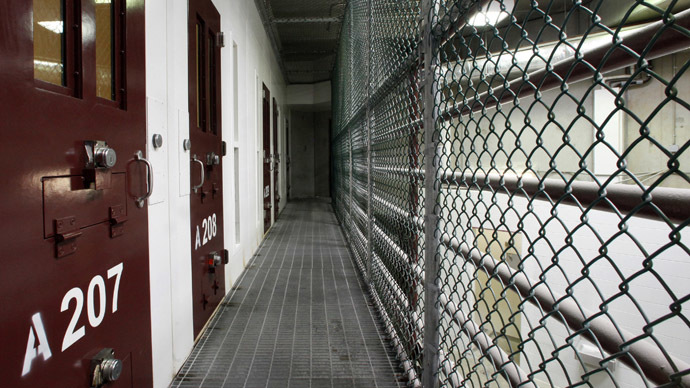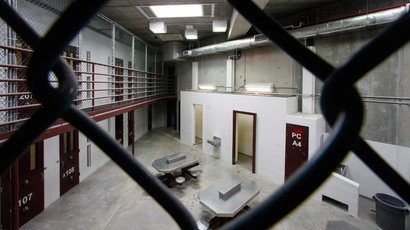Pentagon whitewashes Gitmo hunger strike as ‘long term non-religious fasting’

In December, the US Defense Department shifted to considering the year-long hunger strike among Guantanamo detainees as “long term non-religious fasting”, according to a forced-feeding protocol document.
The 24-page protocol outlining updated feeding procedure is dated Dec. 16, 2013, around the same time the Pentagon ceased its long-standing transparency regarding how many detainees it considered active participants in the hunger strike. The last public report on Dec. 2 listed 15 detainees still actively protesting their indefinite detention at the military prison.
The release, first reported via Vice News by Jason Leopold who filed a Freedom of Information Act request, blacks out sections of the document that delineate how much weight loss and how many declined meals are required to deem a prisoner eligible for twice-daily forced tube feedings.
As the hunger strike went on through most of 2013, some Guantanamo spokesmen suggested that detainees were gaming their weight loss to technically count as a striker according to Pentagon definitions. The updated protocol document provides “medical calculus for how much to force-feed a morbidly obese hunger striker,”wrote the Miami Herald’s long-time Guantanamo reporter, Carol Rosenberg.
The manual calls the hunger strike - which forced the Pentagon to send extra medics to Gitmo last year – a “weight loss” event while describing the forced-feedings as “involuntary enteral feedings.” The additional US Navy medical staff has remained at the camp, equating to a nearly 1-to-1 ratio of staff to captives.
Rosenberg also notes another discrepancy between the newly-released protocol and the older version. It directs staff to opt out of a feeding should they feel “in any danger.”
“If the RN [nurse] or HM [medic] feels they are in any danger of personal harm during an enteral feed, they are to withdraw from the situation and immediately inform the guards of their concerns,” the document states.
The Herald asked a camp spokesman on Tuesday how many of the current 155 prisoners held at the camp are considered by the Pentagon to be “non-religious fasters” and how many are currently receiving mandated “enteral feedings.”
“Our policy at JTF-GTMO [Joint Task Force-Guantánamo] is to not publicly issue the number of detainees who choose not to eat as a matter of protest,” replied Cmdr. John Filostrat.
About half of the 155 detainees have been approved for release, yet the Obama administration must find resettlement or repatriation options for them.
The captives’ protest - which began about one year ago in early March 2013 with six strikers – hit a high last summer, as over 100 prisoners opted out of meals during most of June and July. The number getting tube feedings peaked at 46 detainees, in the latter half of July.
Hunger strike participants dropped to a low of 11 in mid-November and stood at 15 on Dec. 2 when the Pentagon stopped its daily reports of the health situation at the camp. The Defense Department also discarded use of the term “hunger strike” used in previous protocol documents.
Rosenberg noted that Marine Gen. John Kelly – who leads the US Southern Command that has oversight of Guantanamo – had described the protest as “hunger strike lite,” and disputed President Barack Obama’s use of the term “force-feeding.” The new language hews closer to Kelly’s version of the hunger strike, which has included an undisclosed number of prisoners.
Last month, a federal appeals court opened the door for some inmates to challenge their ongoing detention and force-feedings at Guantanamo, though the appellate panel did not outright halt the force-feeding procedures.














